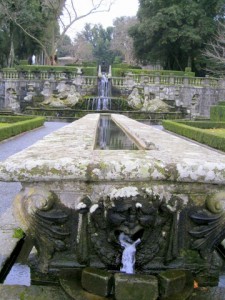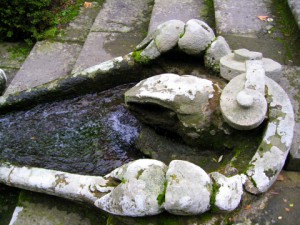Right now, leaves are falling in my garden and the days grow colder . . . I am reminded of a day in mid-January 2009 when a wintry sky threatened rain as I approached Villa Lante in Bagnaia, about forty miles north-west of Rome. Water is a feature of this garden which was begun by Cardinal Gambara in 1568; what a welcome relief from the intense heat of Rome’s summer. The garden tumbles down a hill divided into terraces, formally planted and symmetrically arranged along a central axis, with fountains at regular intervals.
I still recall walking through the entrance gate and immediately identifying the Italian Renaissance manicured geometric regularity embodied in the formal garden to the left; parterres surround a square pool which is enclosed by balustrades. The central fountain features sculptures of four youths holding up the Cardinal’s arms; beyond the wall are the rooftops of Bagnaia. A staircase, flanked by two frescoed casinos and canopied by plane trees, azaleas, hortensia, rhododendrons and camellias, leads the visitor up the hill. As I climbed the stone steps my senses were heightened when I heard the sound of trickling water. Soon the ‘Fountain of the Lights’ (photo below) came into view and an atmospheric smoky haze curled across the area.
The winter clean-up had begun and prunings from summer growth were being raked into a pile and burned by the gardeners. Single jets of water made little impact on sight and sound, however, the design elements of this fountain were interesting, particularly the concentric steps. The upper steps are concave in the manner of an ancient Graeco-Roman hillside theatre, the lower steps convex, with a circular platform in the centre. Unfortunately I was unable to climb the steps (or seats) to the platform due to it being roped off. As I drew closer to the next set of stairs leading up to another terrace there was a more intense sound of voluminous tumbling water.
 Arriving at the top of the stairs, I saw the long ‘Fountain of the Table’ which extended the length of the terrace . Cardinal Gambara apparently had a ‘modern’ taste for eating al fresco and I imagined the stone table with its central water channel being used to float plates and cool drinks as dignitaries discussed literature, art and politics. Water was the perfect unifying metaphor for this Renaissance garden that was intended to inspire intellectual contemplation of man’s taming of nature. Under the table, a grotesque head issuing water from its open mouth brought me back to earth.
Arriving at the top of the stairs, I saw the long ‘Fountain of the Table’ which extended the length of the terrace . Cardinal Gambara apparently had a ‘modern’ taste for eating al fresco and I imagined the stone table with its central water channel being used to float plates and cool drinks as dignitaries discussed literature, art and politics. Water was the perfect unifying metaphor for this Renaissance garden that was intended to inspire intellectual contemplation of man’s taming of nature. Under the table, a grotesque head issuing water from its open mouth brought me back to earth.
My line of vision was directed along the stone table to a theatrical setting dominated by rustic sculptures of two River Gods positioned either side of the spectacular ‘Fountain of the River Gods’ (photo below). The high retaining wall at the rear of the terrace provides a backdrop for the symmetrical arrangement of the fountain. On each side of the fountain is a staircase and a row of columns with ‘antique’ vases which issue thin shots of water into the air. The reclining River Gods command a masterful presence with their deeply incised folds, broad features and piercing deep-set eyes. Water cascades into a basin between a stone sculpture of crayfish claws (a visual motif of Cardinal Gambara’s name: gambara or crayfish) and then into a broader semi-circular pool. Through the curtain of water tumbling from the basin I could just make out curling wave-shaped fish creatures carved into its base. The lower catchment pool is decorated around the edge with grotesque heads whose mouths spout water, contrasting with the graceful swans sculpted on either side of each grotesque.
I was eager to find the source of the torrent of water rushing into the ‘Fountain of the River Gods’ so I climbed the staircase to the left. Water was cascading down the hill along a water chain (catena d’acqua) bordered by scalloped edges, swirling and gurgling as it flowed (photo below). The narrow staircase flanking both sides of the watercourse is hemmed in by hedges and at the top of the chain water flows from a sculpted crayfish head and claws then races down the ‘spine’ to the crayfish legs at the end, over the balustrade and into the domain of the River Gods.
There were more architectural models, fountains and even grottoes to be enjoyed at the very top of the garden (photo below), all created according to the concept of water which goes through a variety of states as it descends the garden’s terraces, manipulated by nature and by man, until the flowing water reaches its idealised form in the water parterres on the lowest terrace. A late 16th century visitor, Fabio Arditio, described the visual effects of water at Villa Lante: “the water gushed, burst forth with foam, or shot up high in the air and was metamorphosed into crystal, silver and fire”.
I will return to Villa Lante on a sunny day during an Italian summer to continue my exploration of this enchanting garden; then I will be distracted by colour, take in the textures and form of plants in full leaf, inhale the fragrances, and appreciate the stone sculptures as sunlight falls on them through a canopy of green. Most of all, I will be delighted as the sparkling water dances, leaps, sprays, splashes and gurgles down the hill, enlivened by the sun.











